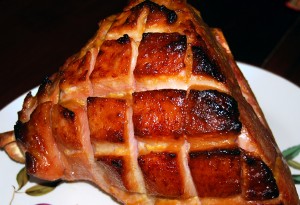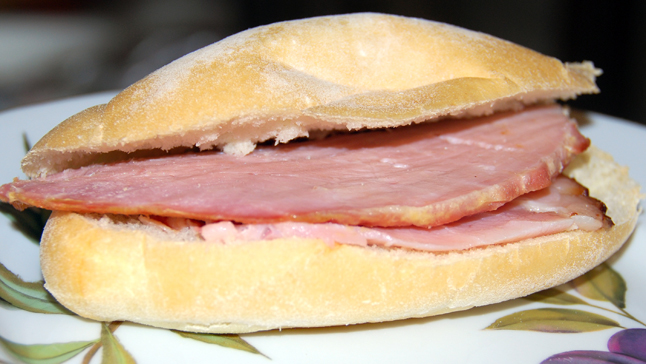
Ham cooked in cider
Canada does not have a specialist ham culture. Maple-cured ham is as Canadian as you get, possibly, but we don’t have, as the Europeans do, Westphalian ham, York, Parma, prosciutto, speck or Iberian ham; nor do we have the American Smithfield or Virginia hams.
One thing is certain: the best-flavoured ham will be one you buy whole or at least by the half-leg— the hank end if possible, bone in, skin on, ready to be cooked in liquid and then baked. The difference is night and day between a big bone-in ham and one of those boned varieties that come wrapped in plastic, or deli ham in vacuum packs needing no cooking at all. A real cooked ham is tender and juicy without being soft, firm but not stringy, succulent and absolutely delicious. There’s no jelly-like sheen, and the meat doesn’t have that elastic quality of pre-cooked ham.
I went for our Easter ham to a butcher in Spallumcheen. The Meating Place (1300 Mountain View Road, 250-306-2887) is run by Barry Williamson, who told me as much as he knew — not much — about the half-leg ham he sold me (5.2 kilos for $34.) This is more expensive than the pre-cooked ready-to-eat boneless hams at local grocery stores, but I was convinced it would be a more satisfying ham. Barry and his wife Jane do the community markets with their custom cut beef, lamb and pork, home-made sausage, and organic chickens, but Kelowna, Vernon and Armstrong take up four days a week, and they sadly don’t come as far as Revelstoke.
One advantage of having a U-Brew in town is that you can make your own cider, and when you see how much is needed here, the point of making your own is clear.
You need a very large pot to boil the ham in before you bake it. A jambonniere is the traditional pot — a very deep oval pot with a lid, large enough for a whole leg of ham. I have never seen one for sale, even on E-Bay. A canning pot does quite well. Leave the canning grid in the bottom and cover with aluminum foil. You will need old oven mitts with plastic bags over them to lift the ham out of the pot. If you can’t get a proto-jambonnière, use a roasting pan with a grill, and use as much cider as possible.
Ham in Cider
The cider in this recipe cooks the ham before you bake it, and imparts a marvelous flavour.
one leg or half-leg, shank end, of ham with bone-in and skin on
5-6 litres of cider
handful of peppercorns
a bay leaf
3 tbsp. brown sugar
2 tbsp Dijon style mustard
Wash the ham and put it into the large pot. Fill the pot to cover the ham with cider. Reserve at least one cup cider for basting later. Bring the cider to a boil, then turn down the heat and simmer for 1-2 hours. If you are using an uncooked ham, the internal temperature of the ham must reach 165F. If the ham is pre-cooked, simmer it for two hours.
Turn off the heat and let the ham cool a little, then using oven mitts with plastic over them, lift the ham onto a board. Discard the broth. Carefully cut away the ham skin, leaving the layer of fat exposed. Score this into a large diamond pattern. Put the ham into a roasting pan with a grill.
Mix the brown sugar and mustard and spoon this over the scored fat surface as well as the flat meat surface of the ham.
If you wish, you can stud the scored fat with cloves. Some people like cubes of pineapple or marachino cherries in the diamond cuts.
Preheat the oven to 425 and place the roaster with the ham in it in the centre of the oven.
After 15 minutes, turn the heat down to 350F. Baste liberally with cider and bake for another 40 minutes or until the glaze starts to turn deep brown.
Remove ham from the oven when the glaze is to your taste, and let the ham rest at least 15 minutes before you carve it.
Serve on Portuguese buns for fast feast food in the Slow Food way. Top with lettuce, mayo or mustard, and salt and pepper. Add a pickle if you like.

Oven fries – yam and potato
I like to do both yam and potato fries, but they require different cooking times, so this is admittedly a complication you might forego. These are oven-baked using very little oil, so are much lower in calories than traditional fries. The steaming shortens the baking time. Once you put them in the oven, it seems at first they will never cook — then suddenly they do, so you have to watch them at the end to make sure they don’t char.
2 large baking potatoes
6 small yams
2 tbsp olive oil
2 tbsp Maletti balsamic vinegar, or other balsamic
coarse flaked sea salt
Peel the yams and potatoes and slice into shoestrings, keeping the two veg separate.
In separate batches, steam the potatoes then the yams for 10 minutes each.
Toss the shoestrings with 1 tbsp. each oil and balsamic, and sprinkle with flaked coarse sea salt. Use two baking pans and spread the shoestrings on the sheets. Bake in a 400° F oven for about 25 minutes, turning once. Sprinkle with more salt at the table.
To drink with this lunch or supper? Cider of course, or beer, or a gutsy white wine such as Sauvignon Blanc, or a Meursault, or a light red — Merlot or a Bordeaux nouveau. At lunch, a sparkling wine would be heady. This is one time an apple wine does down very well.



